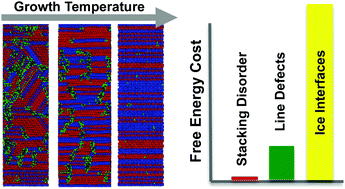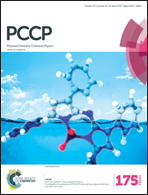Free energy contributions and structural characterization of stacking disordered ices
Abstract
Crystallization of ice from deeply supercooled water and amorphous ices – a process of fundamental importance in the atmosphere, interstellar space, and cryobiology – results in stacking disordered ices with a wide range of metastabilities with respect to hexagonal ice. The structural origin of this high variability, however, has not yet been elucidated. Here we use molecular dynamics simulations with the mW water model to characterize the structure of ice freshly grown from supercooled water at temperatures from 210 to 270 K, the thermodynamics of stacking faults, line defects, and interfaces, and to elucidate the interplay between kinetics and thermodynamics in determining the structure of ice. In agreement with experiments, the ice grown in the simulations is stacking disordered with a random distribution of cubic and hexagonal layers, and a cubicity that decreases with growth temperature. The former implies that the cubicity of ice is determined by processes at the ice/liquid interface, without memory of the structure of buried ice layers. The latter indicates that the probability of building a cubic layer at the interface decreases upon approaching the melting point of ice, which we attribute to a more efficient structural equilibration of ice at the liquid interface as the driving force for growth wanes. The free energy cost for creating a pair of cubic layers in ice is 8.0 J mol−1 in experiments, and 9.7 ± 1.9 J mol−1 for the mW water model. This not only validates the simulations, but also indicates that dispersion in cubicity is not sufficient to explain the large energetic variability of stacking disordered ices. We compute the free energy cost of stacking disorder, line defects, and interfaces in ice and conclude that a characterization of the density of these defects is required to predict the degree of metastability and vapor pressure of atmospheric ices.


 Please wait while we load your content...
Please wait while we load your content...